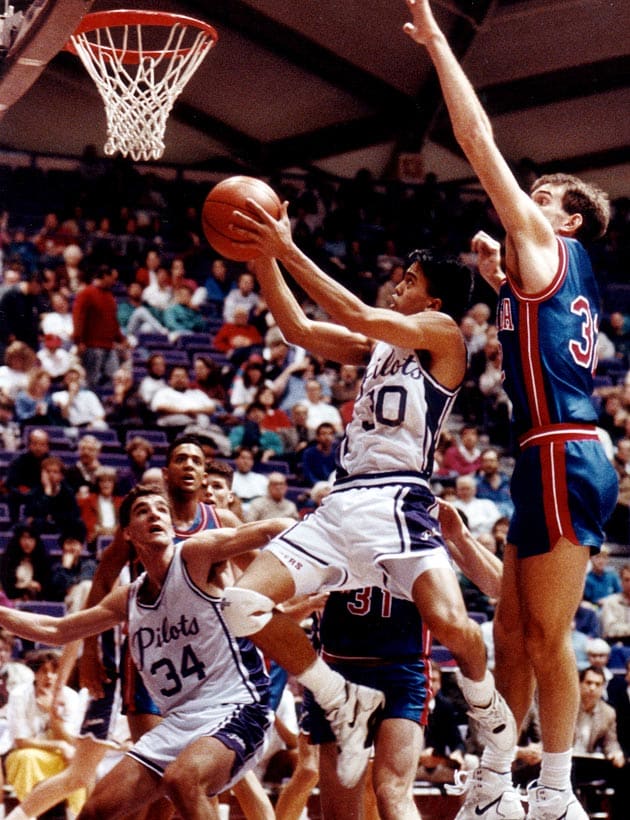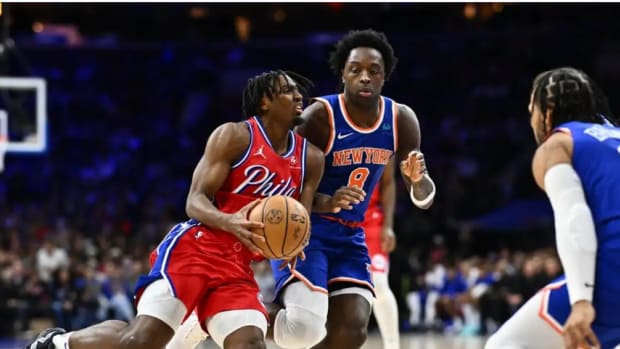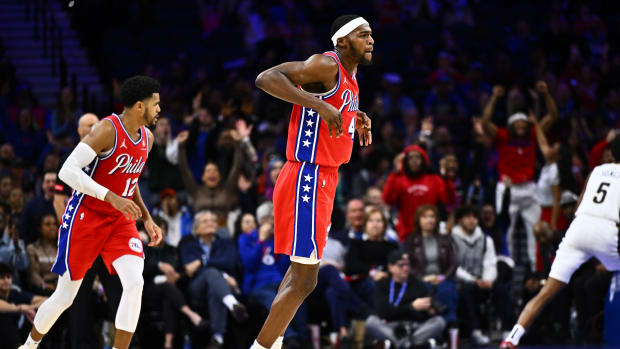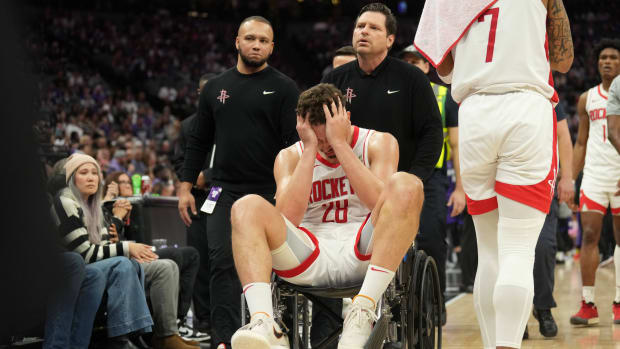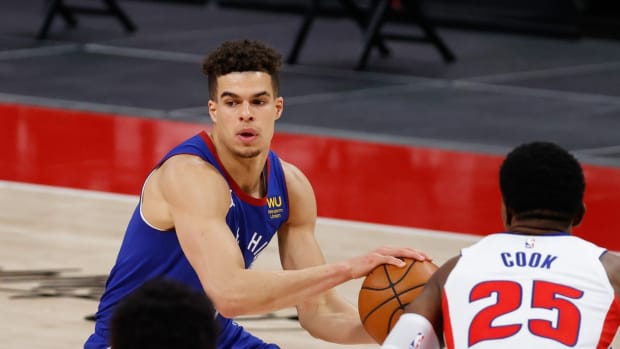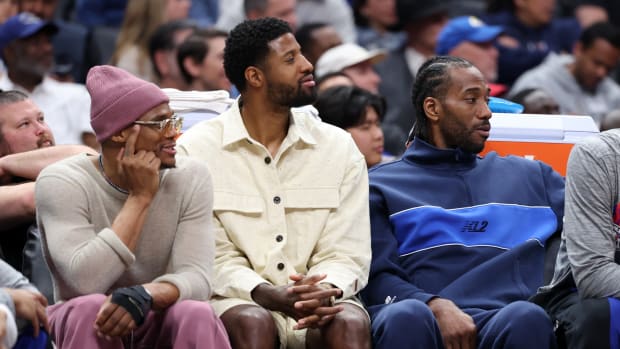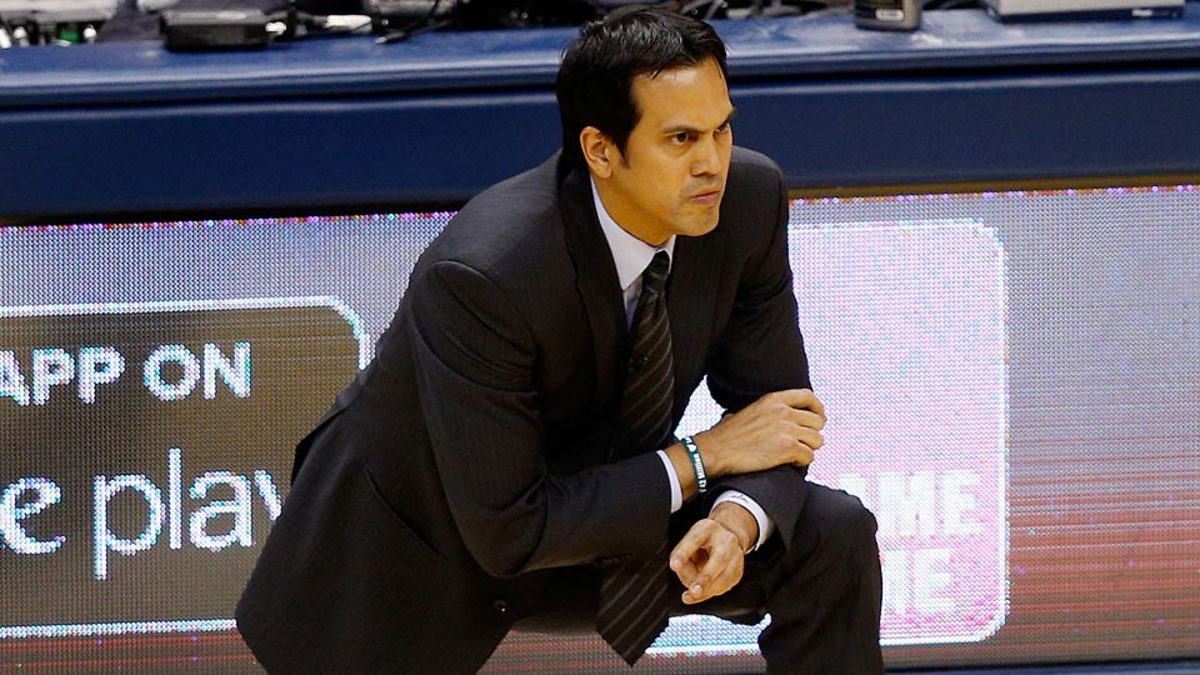
From 'The Dungeon' to the top: Erik Spoelstra's rise with the Heat
This story appears in the Sept. 29, 2014, issue of Sports Illustrated. Subscribe to the magazine here.
You have reached your limit of 4 premium articles
Register your email to get 1 more
On the first Saturday in September, the last player on the court at La Salle High in Miami is a senior guard named Jacknelson Joseph, perched on the left wing in purple shoes and rainbow socks. Jacknelson is a defensive stopper at nearby Calusa Prep, but this evening he is working on his three-point shot, unleashed with a smooth lefty stroke. A coach straddling the half-court line fires go-ahead passes at Jacknelson’s belly and beams as he lets fly. The coach does not critique the player as much as himself. “Oh, that pass is too low. . . . I’ve got to hit you in the chest. . . . There’s another bad one. . . . Can’t have an empty assist. . . . Got to see it go through.” The coach, who owns two NBA championship rings and has reached the past four Finals, is entering his fifth straight hour inside this sweatbox with the nun painted on one wall, the priest on the other and a lion roaring between them.
Nine months ago Erik Spoelstra established a basketball academy in Miami for about 250 boys and girls ages eight through 18 who participate on the AAU circuit while standing apart from it. Nobody gets cut. Everybody plays. Financial aid is based on need instead of talent. Spoelstra writes the rules, suggests the drills and frets over the positioning of the video cameras that record practices. He hires high school coaches—parents are banned from the bench—and requires them to run a read-and-react offense, which emphasizes cutting and passing rather than pick-and-rolls and isolation plays. Zone defense is strongly discouraged. This summer a couple of Spoelstra’s younger squads lost games by 40 points, which disturbs him not at all. He is far more concerned with their eye contact in the huddle. “We’re trying to teach skills and behavior,” Spoelstra says. “We’re not trying to create a superteam.”
The irony is not lost on the 43-year-old coach who presided over basketball’s ultimate superteam, ordering up thousands of pick-and-rolls, designed to unchain the biggest playmaker of all. “Coming here is a break,” Spoelstra says. “It gets me back to the teaching, back to the fundamentals.” In five weekend clinics he floats between frenzied stations, reminding one group to keep its eyes on the rim (“That floor isn’t going anywhere”) and another to tread lightly across the hardwood (“I’m not even going to watch. I’m just going to listen”). When a third-grader launches an air ball, Spoelstra gushes about his footwork and asks for a high five. He recalls a camp he conducted in Zamboanga, a city in the Philippines, with 200 kids, two baskets and a line of armed guards protecting him from suspected al-Qaeda operatives in the area. “This is relaxing to me,” he says. After one session he stands at center court, and a dozen girls huddle around him. Their eye contact is superb. “You could be at the beach right now,” Spoelstra says. “But all your dreams can come true right here—in this gym.”
*****
The Heat began training at La Salle in 1996, when Spoelstra was an entry-level staffer, fetching coaches’ laundry and walking their dogs. His office in Miami Arena was a windowless storage room nicknamed the Dungeon, where he edited video all night, then had cut-ups ready for the team at dawn. La Salle represented a rare opportunity to encounter players in person and in daylight. He shagged rebounds for Keith Askins and Dan Majerle. He lifted weights alongside Tim Hardaway and Alonzo Mourning. He watched Pat Riley put Miami through a practice that started at 9 a.m. and ended at 4:30 p.m., after which the coach told his team, “You think that was hard? We’re so entitled. That wasn’t even a full American workday!”
Beyond the Coconut Grove campus, boats sped through Biscayne Bay and women sold sunflowers on South Miami Avenue, but within La Salle’s borders the Heat forged a personality that belied their tropical surroundings. They were the lion on the wall, ferocious and defiant. “Erik was the guy at the bottom,” says current Miami assistant head coach David Fizdale, “absorbing everything.”
He acted as Knicks point guard Charlie Ward on the scout team and went one-on-one against prospects in predraft workouts. A Magic official, after watching Spoelstra eviscerate a potential draftee at La Salle, lost interest in the prospect but asked Heat assistant Tony Fiorentino, “Who’s the other guy?” Technically, Spoelstra was the video coordinator, but practically he was becoming the soul of an edgy expansion franchise. “He was very sharp,” Fiorentino says. “But he was also very tough. He wasn’t a computer guy learning basketball. He was a basketball guy learning computers.”
Spoelstra felt like Ralph Macchio’s character in The Karate Kid, washing cars for Mr. Miyagi. He progressed to daily 90-minute phone calls with Stan Van Gundy during the assistant’s congested afternoon commute south to Pinecrest. He wrote 25-page reports, on Riley’s preferred blue stock paper, about subjects ranging from pick-and-roll defense to the DNA of a champion. His apartment on Brickell Avenue was robbed three times, and when roommate Tim Scheibe once called to lament the loss of personal mementos, Spoelstra asked, “Did they take my black shirt?” That was the only material possession he seemed to care about, a plain polo.
Promotions followed. A new arena with a shiny training facility opened in 2000. A roster for the ages was assembled in 2010. But Spoelstra ensured that the organization’s underpinnings, laid at La Salle, remained intact. As the young coach of a dazzling team, he didn’t run seven-hour practices, but he did put Dwyane Wade on one side of scrimmages and LeBron James on the other to fuel competition. He played documentaries in the locker room that featured sparring lions. He rejected an office with a view for a windowless alternative down low, another Dungeon. When the Big Three started 9–8, Spoelstra invited a few friends to his condominium and promised them, “I’m not going out like this.” Miami won 21 of the next 22.
The Heat took many jabs, but there were years when they defended with the zeal of the Bulls and passed with the vision of the Spurs. “People will tell you anybody could have done what Erik did,” says Van Gundy, now the Pistons’ coach and president. “I don’t think so. I’ll take my grandkids to see him in the Hall of Fame someday.”
Casual observers may have seen Spoelstra as a babysitter to the stars, but inside the organization he was author and practitioner of The Heat Code, a spiral-bound guidebook filled with theories and quotations that outline the club’s mission. On one page of the manual, handed to players before each of the past four seasons, Spoelstra defines their identity. “We want to be: the hardest working, best conditioned, most professional, most unselfish, toughest, nastiest, most disliked, most prepared team in the NBA.” An unusual number of pictures in the book include blood.
Last September, Spoelstra gathered the Heat at AmericanAirlines Arena before the first day of training camp. They were coming off consecutive championships. He stood at the front of a banquet room. “How many times have you reinvented yourself to become somebody new, somebody better?” he asked them. “But in order to do that you have to be uncomfortable. You can’t stay who you are. . . . Things change and you have to be able to adapt.”
That was a year ago, and yet the words resonate more deeply today. James is in Cleveland and the Heat are no longer a cultural phenomenon. They are just a basketball team again. But unlike so many organizations that implode when they lose a transformational figure—the Bulls with Michael Jordan, the Lakers with Shaquille O’Neal, the Cavs with James—the Heat have stuck together, all that dried blood serving as adhesive. Wade re-signed, Chris Bosh spurned a maximum contract offer from the Rockets, and free-agent small forward Luol Deng chose Miami over a bevy of suitors. “How do you plug the biggest hole ever?” Fizdale asks. “How do you fill that crater? If the Spurs showed us anything [in the Finals], you fill it with teamwork and strategy and system and culture.”
Shortly after James left, Spoelstra sat in the stands at a summer league game in Las Vegas and felt a tap on his shoulder. “Crazy ride, huh?” Phil Jackson said. “Now you can get back to coaching.” But Spoelstra was never rolling out balls. He formulated a scheme in which James could man every position and affect every sequence. Spoelstra ached over ” announcement on July 11, but by nightfall he was starting to reimagine the Heat offense—still heavy on pick-and-rolls but balanced by more Spursy cuts and handoffs. “They won’t be what they were,” says one NBA head coach, “but they could still be top three or four in the East.” Think of a conference semifinal with Cleveland.
Spoelstra flew in August to Los Angeles, where he lunched with Wade and barbecued with Bosh, because he didn’t want his first meeting with them to be in his office. “It was an exhilarating four years and an exhausting four years,” he says. “We had to close the book and open a new one.” For so long, Spoelstra had asked Wade and Bosh to accept lesser roles. Suddenly, he was asking the opposite, challenging them to recapture the responsibility they had grudgingly surrendered. “There were a lot of reasons I didn’t want to leave Miami, and my relationship with Spo was one of them,” Bosh says. “He told me, ‘This is an opportunity for all of us to fill the gap.’ Before, I could afford to step back a little bit at times. Now, I’m excited to step up and be more aggressive, more of a leader.”
There is much they will miss about the era gone by, from the packed arenas to the omnipresent cameras, keeping them consistently on guard and on point. “That electric feeling,” Spoelstra says. “It wasn’t a life less ordinary.” Sometime, early in the season and late in the shot clock, they will find themselves looking feverishly for number 6. Of course, they will miss him too. But during the meals with Wade and Bosh a familiar defiance returned, which Spoelstra described better than anyone in that address before camp last fall:
“It is a relentless, relentless competitiveness to do whatever you have to do to win. You have to develop this mentality. This is who you guys are. This will forever be who the Miami Heat is. There will always be motherf------ in this Miami Heat jersey.”
*****
[pagebreak]
Somewhere in the console of Spoelstra’s black Range Rover is an Earl Nightingale CD. He doesn’t listen to it every week or even every month, but occasionally he’ll queue up the “Dean of Personal Development,” whose reassuring lilt transports him to the kitchen of his childhood home in Portland. On mornings before school, the air was filled with the voices of motivational speakers like Nightingale and Zig Ziglar, reminding the Spoelstras that “we all walk in the dark and each of us must learn to turn on his or her own light.” Erik and his older sister, Monica, had to take notes about the 20-minute cassettes before they could eat breakfast.
Jon Spoelstra was senior vice president of the Trail Blazers from 1979 to ’89, a period when they sold out every game. Jon’s marketing acumen was so renowned that in ’83 he offered two weeks of his services to Indiana for point guard Don Buse—and the Pacers took the trade. Jon doted on his two children but demanded they practice what Nightingale instructed and flip their own switch. He never let Erik win at Monopoly. He threw a Wiffle ball at his chin after a home run. He pushed him ahead in school and sports, where Erik was often the youngest, the smallest and the only minority, his mother having emigrated from the Philippines. “You start out in scramble mode,” Erik says, “and adapt.”
In eighth grade Spoelstra was cut from the A team at Whitford Middle School and responded by uncorking 30,000 jump shots over a single summer, charting each one. Most of the Whitford standouts went to Beaverton High, while he starred at Jesuit, becoming a top player in the state and a pickup rival for future lottery choice Damon Stoudamire. A pattern emerged. Challenges presented themselves, and Spoelstra worked himself into a lather meeting them.
His heroes were coaches, like the Blazers’ Rick Adelman, who had a regulation basketball court in his backyard. Spoelstra played under Adelman’s floodlights, but he also sneaked into his home office, editing VHS tapes of Michael Jordan and Mitch Richmond. He barnstormed gyms around the city with Geoff Petrie, the Blazers’ shooting coach and future Kings GM, to demonstrate Petrie’s techniques. In college he noticed that rival Montana used an intricate series of hand signals, and he deciphered what they meant. “He knew every play,” says former Portland assistant Art Wilmore.
After graduating with a degree in communications, Spoelstra boxed sneakers in the Nike warehouse until the German club Tus Herten signed him to be a player-coach. “Learn the language, eat the food,” his father told him. “Don’t be the ugly American.” Spoelstra adapted again. He was the point guard and lead assistant for Hubert Beck, reviewing plays at the pub; on the side, he coached a team of 12-year-olds who didn’t speak English. All the while, he subscribed to a service that sent him videos of NBA and college games a week late.
Spoelstra recalls in detail two events from his playing career, both at Portland. The first came in the 1990 West Coast Conference tournament, when he rushed back on defense against Loyola Marymount, only to see Hank Gathers soar for an alley-oop. Gathers collapsed moments later a few feet away and died that night. The second involves a less heralded power forward named Matt Houle. Spoelstra was easily winning a two-mile race against his teammates when he noticed Houle gaining on him. Spoelstra grew anxious, broke into a sprint and threw up after crossing the finish line first. He dry-heaved for the next 20 minutes.
Beneath Spoelstra’s bold speeches is a fear of failure that was not always easy to conquer and channel. He accepted the job as head coach at Sherwood (Ore.) High but backed out a week later so he could return to Germany. He only applied for the Heat’s video coordinator position in 1995 as part of a bet with his German teammates. When a club official called with a date for an interview, Spoelstra was inclined to pass because he had tickets to a Grateful Dead concert. Even after landing the gig, he was ready to turn it down until his sister called and asked if he’d lost his mind.
When the Heat promoted him to advance scout in 1999, he balked, partly because he didn’t think his penmanship was as neat as his predecessor’s. When Riley made him an assistant coach two years later, he resisted again, wondering how he could reach his boss’s exacting standards. “I was comfortable and change scared me,” Spoelstra says. “I’d get this pit in my stomach, that fear of being a disastrous failure.” He compensated with work, starting at 4:45 a.m., compiling reports on every team in the league when other staffs were splitting the load.
“We went to Miami for Christmas one year and were all unwrapping presents in the hotel,” recalls Monica, who is now a nutrition counselor and lifestyle coach in Portland. “He fell asleep on the floor.” Each spring Spoelstra put out feelers for college openings, believing he could advance further at a lower level. Van Gundy finally wrote him a letter that read, “You can coach in this league.” Spoelstra still keeps it in his office desk.
By 2007, Riley was tiring. On the team plane after losses, Miami’s coach and president would tell Spoelstra, “Get ready for this.” Spoelstra laughed nervously. “Don’t joke about that,” he replied. Nobody remembers that Spoelstra piloted the Heat in ’08–09 after Riley went upstairs full time, taking them from 15 wins to 43, or in ’09–10, when they won 47 games with Michael Beasley as their second-leading scorer. Spoelstra entered the public consciousness only in the summer of ’10. His buddies took him on a getaway to Las Vegas, which they termed the Last Weekend of Anonymity. The pit resurfaced.
“People assume a good team is easy to coach,” says Adelman. “But the pressure to maintain the trust of these talented players, and keep the whole thing from disintegrating, is very hard.” Every day was like another two-miler at Portland. Spoelstra started with a huge lead but saw the field closing on him. Most of the time he held it off. On the rare occasions he didn’t, the despair was deep because the expectation was immense. “I hate this quality, but I can go to dark levels when we lose,” Spoelstra says. “It’s not a panic attack, but there’s anxiety. I’m inconsolable. I’m a train wreck. I’m being myself. Then I get this crazy, intense focus, where I get desperate not to be embarrassed again. That dark spot is what I tap into. Creativity comes from there.”
He pours his anger into his laptop. Spoelstra keeps daily notes on everything from historical events to pick-and-roll actions. His entries include stats (“We’ve been outrebounded in eight of 11 games”) and quotes (“MLK: ‘We must live together as brothers or perish together as fools’ ”), questions (“How has success changed us?”) and definitions (“Hubris—extreme pride or arrogance that often indicates a loss of contact with reality and an overestimation of one’s own competence”). He addresses individual players (“You’re stubborn and how is that working for you?”), the group (“Let’s come up with a solid solution, not just say we need to ‘ball’ ”) and himself (“Do I seriously have to prove myself in our fourth year? Yes. It never stops. The process never stops”). He muses (“It’s always easier to sacrifice when you’re not the one who has to do it”) and motivates (“We can’t lose when you have blood on you”). He stresses snacks (“Peanut butter, almonds, apples”) and sunlight (“Vitamin D”). He is upbeat (“All of you are good but all of you together is overwhelming”) and downcast (“God forbid if you’re thinking about your vacation plans”). He tends to use all caps.
Sometimes Spoelstra won’t remember what he wrote after a game. “When I was a player I’d black out and shoot for hours,” he says. “Now I’ll work through the night until the next afternoon when I see the team.” His assistant Dan Craig will tell him, “I really like the talk you just gave the guys.” Spoelstra looks at him with a blank expression. “I have no idea what I just did,” he replies.
The Heat sense when he is entering a spiral. After a last-second loss in Indiana last March, James spotted Spoelstra typing furiously on the plane. Spoelstra had used James as a decoy on the final play, a decision that backfired. “You’re not still worried about that, are you?” James asked. “Yeah, I’m pissed,” Spoelstra groaned. “I’m good,” James said. “We’re good.” Likewise, after the team dropped Game 1 to the Pacers in the Eastern Conference finals, Bosh knocked on the door of Spoelstra’s hotel suite. He was holding two beers. “Just checking on you,” Bosh said. “I know you’ll get it right. You’ll get us right.”
*****
Once it is lost, anonymity does not return. When Spoelstra walks into the neighborhood Starbucks, his coffee and oatmeal are prepared by the time he reaches the counter. When he strolls through the lobby of his condominium, a middle-aged man asks, “Sixty wins this year?” It is unclear if he is joking. Spoelstra does not smile. “Working on that,” he responds.
The first time Miami fell in the Finals, to the Mavericks in 2011, Spoelstra installed an organizational “improvement program.” He ordered coaches to read books and attend clinics, then write reports about what they learned. One staffer was instructed to mine every Malcolm Gladwell article for relevant thoughts. Spoelstra, who listened to John Maxwell leadership CDs on the drive to work every day, was taking the equivalent of 30,000 jumpers again. He discovered a book by Carol S. Dweck called Mindset and became consumed with the distinction between a growth mind-set and fixed mind-set.
“When you subscribe to a growth mind-set, you challenge yourself to do things differently, and you actually produce a drug in your brain that allows you to work more creatively,” he says. “That’s when you’re most alive.” For someone naturally wary of change, the material was revelatory. Spoelstra and his assistants got into peak shape so they could carry lessons onto the practice court, where they devised the pace-and-space offense that yielded two championships, along with a 27-game winning streak in 2012–13. Love them or hate them, the Heat were the first superpower of the Information Age. They had to be seen, heard and tweeted about. They simultaneously bemoaned the scrutiny and fed off it.
But last season, practice habits slipped, and performance followed. The Heat still won the East, though their ball movement wasn’t as crisp and their defense wasn’t as active. Spoelstra’s notes from around Christmas revealed a team on the precipice and a coach desperate to pull it back from the edge: “This is the biggest challenge we’ve gone through so far. We haven’t really been right for a while. We’ve just been winning. Initially, I thought it was just the dog days. But it’s deeper than that.” In the Finals, players looked spent, and afterward they seemed almost resigned. “You sensed there would be change,” Spoelstra says. “How big of a change, I’m not sure anybody could tell. But it was the end of that team and we all knew it.”
He sits on the balcony of his 10th-floor condo, overlooking Biscayne Bay but struggling to savor the view. “I’m not presumptuous enough to think you should always win,” he says. “But you had that team. We were that team.” Two titles in four tries, by his uncompromising math, weren’t enough. “It drives him that we didn’t get them all,” Fizdale says.
Spoelstra is single, with a girlfriend of four years, their courtship coinciding with the Big Three era. Inside the condo are pictures that trace his basketball life: the hoop in his Portland driveway; the 1995–96 Heat pedaling on stationary bikes; Wade, sinking identical game-winners, under the inscription, “To Spo, a lot of hours on this one.” Spoelstra enters the next phase armed with an advanced education in management, media and the unique psychology of the NBA megastar.
His process will not change just because the preseason predictions do. He will still agonize over every setback, then retreat to one of the three yoga studios where he is a member and breathe it out. “I like yoga because you have to keep your eyes on your own mat,” Spoelstra says. “If you’re not focused on the spot in front of you, you’ll fall over.” Less than a month remains until training camp, and he is asked what he will tell the team, what messages will fill his daily notes, what the offense will look like on opening night. “I don’t know yet,” he says. The pit is back in his gut, that fear of spectacular failure, no different from when the Heat made him a scout. It is a source of discomfort for Spoelstra but assurance for everyone around him. He attacks it and dissolves it every time. He adapts and reinvents. He turns on his own light.
At AmericanAirlines Arena, Spoelstra pulls a copy of Mindset from a shelf in his office and flips through the dog-eared pages. He will need to employ the growth mind-set again. He heads upstairs to the practice court, where first-round pick Shabazz Napier is shooting jumpers, and they make small talk. The championships alone give Spoelstra a locker room credibility that no current coach besides Gregg Popovich and Doc Rivers can match. Add those rings to the allure of Miami plus the gravity of Riley, and the Heat will be back. Maybe not this season, but they will be back. “Players know more than ever they have a man who can lead them to the promised land,” Riley said. “It takes a long time to gain that kind of respect.”
Spoelstra is meeting on the practice court with 16 coaches from the academy. He stands next to a TV screen, starting and stopping video from the Heat’s off-season workouts. He shows backdoor cuts used to counter ball denials that flummoxed his team in the Finals. He believes pros should be working on the same skills as third-graders. Back to the teaching, back to the fundamentals.
He then turns the floor over to Rob Fodor, a 54-year-old shooting guru who can still hang from the rim when the urge strikes. Fodor is not a full-time member of any staff, but he has become a confidante to the Heat coach, ever since they met in a Miami gym 12 years ago and Fodor helped Spoelstra improve the timing on his own jumper. “You need a mental curiosity to do this job,” Fodor says, “and he never stops looking for new answers.”
Today Fodor uses Spoelstra as his subject, positioning him at the top of the key. He pushes down on Spoelstra’s left foot, forcing him to take an explosive first step with his right. Spoelstra dribbles twice to the free throw line, tucks the ball on his hip and rises up. Then he retreats and does it again, over and over, until the rhythm feels just right. He never actually shoots. He is entranced by a drill that could not seem more mundane. Finally, he turns and eyes Napier, unleashing threes on the other side of the floor. He can’t fill the crater all at once. But he can help a rookie point guard take a faster first step.
“This,” he says, “is what we’ll dig into tomorrow.”































